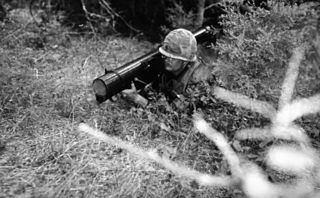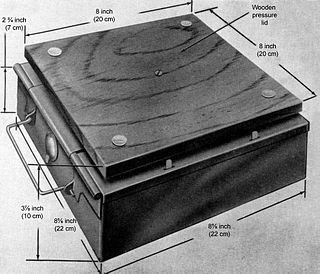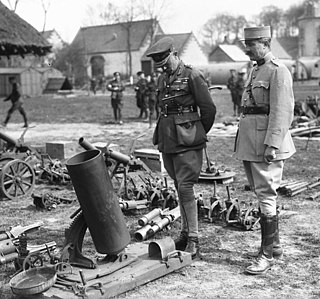
The LAW 80, regularly referred to as LAW 94 in British service, is a man-portable, disposable anti-tank weapon previously used by the British Army and a few other militaries.
Type 72 Non-Metallic is a Chinese circular, plastic bodied landmine which is designed to damage or destroy a vehicle by blast effect.
The PP Mi-D mine is a Czechoslovakian copy of the German Second World War Schu-mine 42 anti-personnel mine.

The TM-46 mine is a large, circular, metal-cased Soviet anti-tank mine. It uses either a pressure or tilt-rod fuze, which is screwed into the top. Anti-tank mines with this type of fuze were capable of inflicting much more damage to armored vehicles, when compared to a typical anti-personnel mine.
The TMD-44 and TMD-B are simple rectangular Soviet wooden box cased anti-tank blast mines, they were both used during the Second World War. Both mines are similar in design, differing only in fuzing mechanism. The wooden construction of both the mines makes them unpredictable as rot and insects can eat away the wooden case, reducing activation pressure to as little as 3 kg. Both mines are found in a number of countries including Afghanistan, Angola, Chad, Cuba, Egypt, Korea, Mozambique, Namibia, Rwanda, Yemen, Zambia and Zimbabwe.

The M15 mine is a large circular United States anti-tank blast mine, first deployed during the Korean War. Essentially, it is a larger version of the M6A2 anti-tank mine, which it replaced. Although the M15 has been superseded by the M19 mine, the U.S. retains large stocks of M15s because they are still regarded as reliable and effective weapons. When used against main battle tanks the M15 is primarily a "track-breaker" which creates mobility kills, but has a comparatively small likelihood of causing crew fatalities. However, when used against light vehicles such as APCs or unarmored vehicles such as trucks the damage it can inflict is much more severe.
The M7 is a small, metal-cased United States anti-tank blast mine that was used during the Second World War. It was based on the British Hawkins grenade. Approximately 2.5 million were produced before production ceased, and although it has long since been withdrawn from U.S. service, it can be found in Angola, Burma, Cambodia, Chad, Eritrea, Ethiopia, Korea, Lebanon, Myanmar, Somalia, Thailand, and Zambia.

The M19 is a large square plastic cased United States anti-tank blast mine. Intended to replace the M15 mine, the design dates from the mid-1960s and contains only two metal components: the copper detonator capsule and a stainless steel firing pin which weighs 2.86 grams. It is a minimum metal mine, which makes it very difficult to detect after it has been emplaced. This mine is produced under licence in Chile, South Korea and Turkey. A copy is produced in Iran. It is found in Afghanistan, Angola, Chad, Chile, Cyprus, Iran, Iraq, Jordan, South Korea, Lebanon, the Western Sahara, and Zambia.
The M6, M6A1 and M6A2 are a series of metal-cased, circular, heavy anti-tank landmines produced by the United States from May 1944 to May 1945.
The MAT-76 is a large circular Romanian minimum metal anti-tank blast mine. It is similar to the MAT-62B mine, sharing a fuze. The mine is actually a cast block of TNT with a thin coating of fibreglass. The mine has a central fuze well that normally uses a P-62 pressure fuze, although it can be used with any of the fuzes designed for the Russian TM-62 and TM-72 series of mines. The bakelite plastic used in the fuze of a MAT-76 may become brittle in desert conditions, which can reduce the activation pressure. This may make the mine unstable i.e. can detonate simply by handling it. The mine is found in Angola, Iraq, Kuwait, Liberia, Mozambique, and Zambia.

The M21 is a circular United States anti-tank landmine that uses a Misznay Schardin effect warhead. The mine uses an M607 pressure fuse, which can be adapted as a tilt rod fuze. The mine is triggered either by pressure, or by the tilt rod being forced beyond 20 degrees from the vertical by a force of more than 1.7 kg, either of these actions results in pressure being transferred via a bearing cap to a Belleville spring, which inverts, driving the firing pin into the M46 detonator. The M46 charge first ignites a black powder charge, which blows off the mine's cover, and clears any earth or debris that may have been on top of the mine. A fraction of a second later the main warhead detonates, driving and compressing a steel plate upwards, with enough force to penetrate 76 mm of armour at a distance of 530 mm. Approximately 200,000 M21 mines were produced in the U.S. and licensed copies, the K441 and K442, were produced in South Korea.
The Na-Mi-Ba is a Czechoslovakian minimum metal bakelite cased anti-tank blast mine. The mine uses a horizontal lever fuze, with a very low operating pressure that breaks open a glass capsule containing acid, which initiates a flash composition. The mine has a small main charge, and is normally used as the initiator for larger charges. The low operating pressure means that the mine could be used as an anti-personnel mine.
The Model 67 is a square plastic cased Austrian minimum metal anti-tank blast mine. The mines pressure fuze sits on the top of the mine, with a provision for an anti-handling device. A second version of the mine the ATM-75 is similar to the Model 67 mine.
The MKT Mod 72 is an Albanian circular, metal-cased anti-tank blast mine, a copy of the Russian TM-46. Two versions of the mine are produced, the PX designated version of the mine is fitted with a secondary fuze well in the base of the mine that accepts an MUV type anti-lifting device. The mine uses a mechanical pressure fuze similar to the Russian MV-5.
The ATM-74 is a North Korean wooden box mine, it is a copy of the Soviet TMD-B. It is a wooden box packed with blocks of TNT, the top of the mine has three planks of wood underneath the central plank is a pressure fuze similar to Soviet MV-5 pressure fuze.

The TM-35 was a rectangular, metal-cased Soviet anti-tank mine used during the Second World War. The mine has a metal case, which is rectangular with a carrying handle on one side and a large raised pressure plate in the centre. Sufficient pressure on the central pressure plate presses down on one end of an internal see-saw like lever, which removes the retaining pin from an MUV fuze, releasing the striker, triggering the mine.

The T-IV was a Soviet anti-tank mine developed before and used during the Second World War. The mine has a metal case with a wooden pressure plate attached to the top of the mine. It is similar in configuration to the later TM-38.

The TMRP-6 is a former Yugoslavian anti tank EFP mine.

The 24 cm schwerer LadungsWerfer Ehrhardt shortened to 24 cm sLW Ehrhardt,('24 cm heavy charge thrower Ehrhardt' in English) was a heavy mortar used by the Imperial German Army during the First World War.
The ML-7 is a Soviet booby trap mine that serves the purpose of an anti-handling device for explosive charges or other anti-personnel mines. The ML-7 is generally used with PMN-1, PMN-2 and PMN-4 mines, but can also be used with any other item over 0.3 kg in weight.









